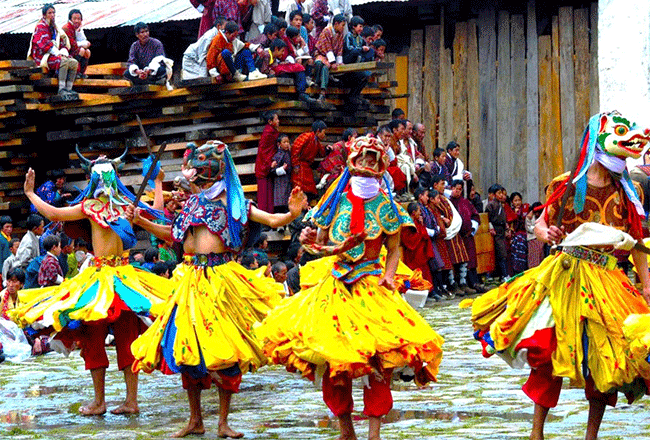“Far away places with strange sounding names
Far away over the sea
Those far away places with the strange sounding names are
Calling
Calling me.”
— “Far Away Places” by Alex Kramer and Joan Whitney. Copyright Bourne Co.
I was 10 years old when I heard this song and knew it was beckoning me. Now, eight-decades later, those “faraway places” are wonderful memories. Among the most wonderful memories and strangest-sounding-names was that of Bhutan, Kingdom of The Thunder Dragon, so I had to go.
Oddly enough, I met Bhutan’s Gangteng Tulku Rinpoche at a Buddhist retreat on the slopes of Kit Carson Mountain in Colorado. He was a Tulka, or “Living Buddha,” from the Gangteng Monastery in the Kingdom of the Thunder Dragon. The Rinpoche, meaning “Precious One,” traced his lineage to the Shakyamuni Buddha in the 6th century B.C. He was the ninth body incarnation of Padma Lingpa, the patron saint who envisioned the monastery 500 years ago. Got that?
When I returned to my home in Scarsdale, this unique invitation was waiting:
It brings me immense joy to announce the display of the most sacred treasures of Gangteng Monastery. I am undertaking renovation of Gangteng and must dismantle much of this ancient structure. This necessitates the transfer of precious treasures from the innermost chambers of the monastery where they have been preserved for 400 years. This gives me an opportunity to share the viewing of these precious treasures for the first time in Gangteng’s history.
This event will be celebrated with the Seven Day Great Accomplishment Ceremony, followed by 5 days of dancing by the monastery’s lamas. On September 17, 2002 these treasures, until now only viewed by the 9 incarnated Gangteng Tulkus, will be revealed to those fortunate to be present.
I hope you will join us for this auspicious occasion and experience the profound blessing of Gangteng’s spiritual heritage. Tashi Deleg
Kuenzang Pema Namgyel, Gangteng Tulku
I was among a few foreign guests who flew from Bangkok by Druk Air in one of Bhutan’s two small planes, (no seat belts but blessed by lamas). We landed at Paro, a high and relatively short airstrip, and continued by bus up the steep mountain road to Gangteng Monastery, “Mountain Fortress of the Gods,” standing close to heaven in a high alpine valley. The Buddha was born of a lotus, so the monastery is symbolically akin to the heart of a lotus blossom cupped by the snow-capped Himalayas, like frosted petals. The Tulka welcomed us into the monastery’s flagstone courtyard where lamas in fearsome masks and flamboyant costumes were dancing 12 legends glorifying the Guru Rinpoche. The sacred dances (Tshechu) were choreographed in the 15th century by Padma Lingpa, the first Gangteng Tulku.
According to folklore, the Guru, an Indian mystic known as the Second Buddha, flew from Tibet on the back of a flying tiger to bring Buddhist dharma to Bhutan in 747 A.D. He lived a thousand years, performed multitudes of miracles and melded the Bonn religion with Buddhism. Before entering Nirvana, he concealed treasures in the Himalayas to be found, when needed, by treasure keepers. Thousands of excited devotees had trekked for miles to be empowered by the ceremonies.
Bhutan — the size of Switzerland with 600,000 people sandwiched between two populous giants, China and India — is the sole surviving Buddhist kingdom in the Himalayas. The others were swallowed by larger powers. Islam overran the Buddhist civilizations from Afghanistan to Mongolia in the 10th century. In the 1950s, Tibet, was claimed by China, India absorbed Ladakh and, in 1975, the kingdom of Sikkim became an Indian State.
The kingdom of Bhutan discovered the wheel in 1967. Before that, foot or horseback was the only way to go. Bhutan skipped the Industrial Age, two World Wars, the sexual revolution, the arms race and even, until recently, cyberspace. Today the kingdom is striving to emerge as a modern nation committed to achieving economic development and prosperity while preserving a pristine environment and rich cultural heritage. In 1997, the fourth king made world headlines by declaring “Gross National Happiness” as Bhutan’s main concern.
I asked the Tulku if they planned to bring electricity to this valley. He said: “This is the winter residence of 300 black-necked cranes from Siberia. It is a wildlife preserve. We can’t string overhead wires that would interfere with the cranes’ migration. When they arrive in October, they circumnavigate the monastery three times. How could we interfere with them? First on my wish list is roads and second electricity. We don’t have plans to bring electricity here until we get underground cables. The cranes take priority.”
I was trembling with excitement as we entered the inner sanctum to see the treasures. No photos. Some, like the Buddha who cried real tears for the state of the world, were crafted by divine beings. Other treasures were created by masters of India, Tibet and Bhutan. When I touched a golden elephant, an electric shock stunned me. The Tulku said; “Simply by being in the presence of these objects you are blessed. If you make a wish it will be fulfilled within your lifetime.”
And if you can’t believe this story don’t go to The Land of the Thunder Dragon.




